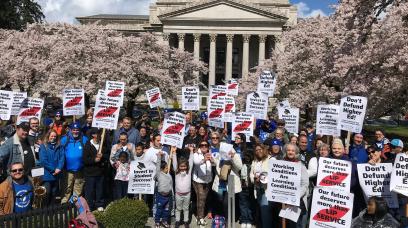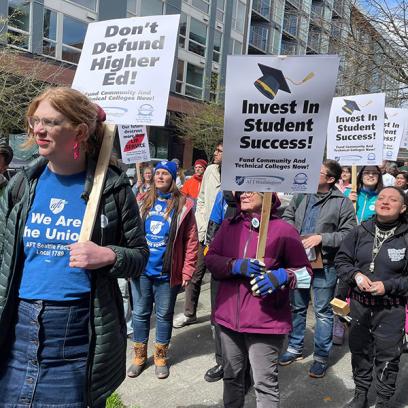Faculty, staff, students and community members rallied at several college campuses in Washington state and at the state Capitol building for a full-throttle Day of Action April 11. Through walkouts, teach-ins, social media and picketing, educators and allies demanded full funding for the crucial work being done every day at community and technical colleges in Washington state.
Among the top issues driving the day were supports for students—about half of whom are students of color, many from low-income communities who are the first in their families to attend college—as well as pay equity for part-time faculty and fully funded cost-of-living adjustments.
“Our state’s leaders know we need an educated workforce for the jobs of the future and our CTCs [community and technical colleges] provide every pathway you can imagine—workforce training, high school completion, transfer degrees, apprenticeship,” says Karen Strickland, president of AFT Washington. “Everyone agrees on the goal—that 70 percent of Washingtonians will attain a post-high school credential, degree or apprenticeship—but the investments needed to reach the goal aren’t there. With the state’s allocation for CTCs increasing only 2.7 percent in this budget, that’s a budget cut!”
AFT Washington has been advocating for several bills introduced by Communities for Our Colleges, a student-centered, student-led coalition of students, community members, CTC workers and labor unions including AFT Washington. “Investing in our CTCs is an investment in racial and economic justice, it’s an investment in people’s future,” says Fernando Mejia Ledesma, an organizer with C4C. “We need to invest in the whole student … to support our students so they don’t fall through the cracks.”
The reason behind the fight
For more than 30 years, the state Legislature has underfunded community and technical colleges, yet these institutions contribute more than $20 billion to Washington’s economy every year, offering a pathway to high-quality jobs and a secure future for countless students. In fact, more than 65 percent of all higher education students in Washington attend CTCs.
Many students are struggling. According to the Washington Student Achievement Council, 40 percent of CTC students faced food insecurity in 2019, and in 2022, more than a third of Washington higher education students experienced housing insecurity. Many students drop out because they are unable to meet child care costs, or because they have to work so many hours in order to pay their tuition they don’t have enough time to attend classes.
Rachel Dorn, an art professor and president of the faculty union at Yakima Valley College, sees exactly how heavy work schedules can jeopardize student success: She recalls one student who was frequently confused and behind the rest of the class, until one day he answered every question. When classmates asked what had changed, he said he hadn’t worked the night shift at McDonald’s the night before. Another student told Dorn she was failing a class because she was bad at math, but when Dorn learned the student had a newborn baby and was also working at a retail store, she said, “You’re not bad at math, you’re exhausted!”
“If we can provide some more substantial financial support, we could get fewer students needing to work or at least working fewer hours,” says Dorn, and that would serve not only the student but the community. “We’ve got 17- and 18-year-old students who are helping to pay the mortgage. They’re helping to raise the kids in their family. When we get that student up to a higher paying level by giving them access to degrees and certificates, they raise up six other people.”
Faculty strains
Meanwhile, the faculty and staff who teach these students are being shortchanged and find it difficult to stay in their jobs. CTC workers are paid at least 12 percent less than workers in comparable states, the union reports—leading to double-digit turnover. “Our stagnant wages have driven many of my colleagues to leave our district, and we now have a vacuum of faculty, support and institutional knowledge,” says Cristóbal Borges, a history professor at North Seattle College, whose own multigenerational family of four lives in a 900-square-foot, two-bedroom apartment, unable to afford a larger home. “We love Seattle and want to continue to live in the community we serve, but currently it is becoming harder and harder to stay here.”
In addition to insufficient faculty funding, entire vocational programs have been threatened. Last year, programs in maritime studies, wood technology, apparel design and culinary arts were nearly axed due to budget cuts. While the communities fought successfully to keep them, future funding remains uncertain.
“Much of our society does not understand what community colleges do,” says Borges. Colleges partner with food banks to distribute food, donate clothing and counseling, connect unhoused people with services and still help students achieve their academic goals. “We teach those with the most need on a daily basis, yes, but we also have as central to our missions to help everyone that walks through our doors.”
Legislators, however, consider completion rates to be the best indicator of “success” and want to withhold funding when rates are low. Community college is so much more than that, says Borges. “When a student walks into my classroom with learning disabilities, unhoused and hungry, a completion rate does nothing to measure how well I and our institution served them.”
Those students—and all students—deserve fully-funding community colleges.
[Virginia Myers and AFT Washington communications staff]



